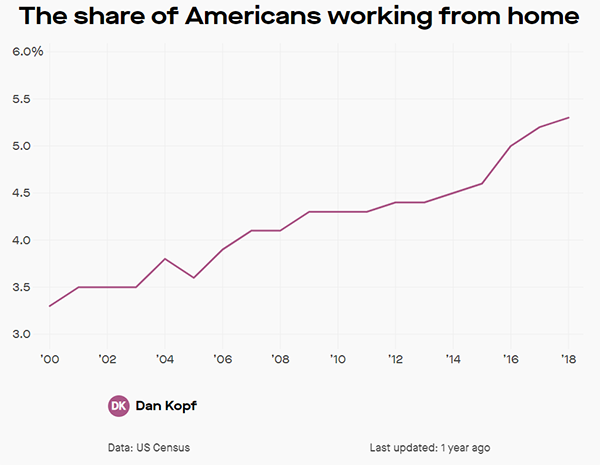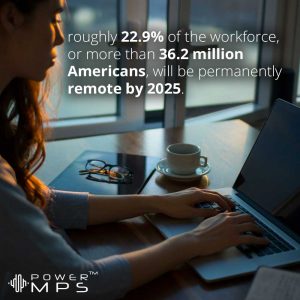The Rise Of The Remote Work-From-Home Workforce
The 2020 COVID-19 pandemic created chaos in the workspace, forcing companies to find new ways to operate outside the traditional workspace. For most of us, working from home was considered to be an impossibility. Few businesses had reason to consider a remote workforce as something worthy of research, investment, or consideration as a part of their future development.
Yet, as of December 2020, around 71% of employed adults performed at least a portion of their jobs from their homes. And, while some individuals have voiced a desire to get back to the office, approximately 54% of workers have said they would like to continue having work-from-home flexibility in the future. How did we realize such a startling turnaround?
The Rise Of The Remote Workforce
It all began when the world was introduced to SARS-COV-2, the virus which causes COVID-19. Understanding this was an easily transmissible disease, and with limited knowledge of its potency and long-term effects, governments were quick to implement widespread shutdowns and regulations, including school closures.
Many businesses, faced with growing demand from parents, who now must stay home with their children, and rising health concerns from other employees, were forced to investigate and invest in the technology required to facilitate a remote workforce and keep their business operating.
Suddenly, software as a service (SaaS) and connected services companies such as remote monitoring software, cloud-based database options like Microsoft Azure, secure VPNs, video conference and meeting software like Zoom, project management platforms such as Slack and GroupMe, and managed print services software like PowerMPS are getting a boost of buy-in and market share.
Where Did Remote Work Technology Come From?
While most of us have believed working from home was a pipe-dream, the hardware, and software to facilitate a remote infrastructure have long been in development.
Building on growing speed and access to the internet, innovative technology companies have been working to find ways that reliably keep business travelers connected and find ways to support international and regional offices operating as a united organization. As a result, the past couple of decades have been a boom for customer management, communications, and cloud storage tools.
As businesses continue to expand beyond local, state, and even national borders, tools to consolidate and manage other standard operations have also grown in demand. Order automation software, managed services software, and performance metrics tracking are just a few of the mechanisms upon which companies have come to rely.
In addition to connecting satellite offices, these technologies had an unexpected benefit; they made it possible to begin allowing a small number of employees to work from home. In 2000, 1.9% of employees in the USA worked from home full-time. By 2017 there were roughly 6.5 million full-time at-home American workers while around 23% of the US population worked from home for at least a few hours per week. All of these statistics began to impact the MPS industry and will continue to into the future.
Then the Coronavirus arrived, and companies who had never even imagined a remote workforce quickly discovered what more adventurous and agile businesses had known for years. They found that secure work-from-home is an affordable and achievable alternative to the long-standing office format. In many cases, it has been shown to increase productivity by an average of 13%.
The Future Of Work-From-Home
With fears of the COVID-19 outbreak waning, governments have begun systematically removing shutdowns and restrictive regulations. Some earlier predictions in 2020 assumed things would return to “normal” post-pandemic, with most workers returning to an office setting. However, many companies have signed contracts and made significant financial commitments to keep their businesses running over the past year. And, while some big-name organizations are making moves to double down on offices as a “community meeting space,” a large number of institutions are seeing the advantages of reducing business-owned workspace costs, increased employee efficiency, and lower attrition.
As of the first quarter of 2021, as offices re-open and employees are allowed to slowly return, 26.7% of the workforce is working from home full-time. Even if things do gradually return to “normal” office space culture, roughly 22.9% of the workforce, or more than 36.2 million Americans, will be permanently remote by 2025. That is over an 87% increase in the number of remote workers prior to the Coronavirus pandemic. But it also shows that work-from-home is no longer a trend. Rather it is a valid option for businesses to use in their ongoing strategy, recruiting, and operational plans.
It is unlikely that large offices will completely disappear. After all, studies show face-to-face interactions are still an essential part of building successful, long-term relationships, and there are some industries and positions where the work can’t be performed at home. But it is estimated we can expect to see over a quarter of the USA workforce operating remotely within the next ten years.
Businesses that continue utilizing office spaces will have to reimagine their workforce to take advantage of a mixture of on-site and work-from-home employees. This hybrid workforce style will prioritize the use of integrated software solutions to facilitate efficiencies across the in-person and remote workforce. All-in-one cloud-based software, such as PowerMPS, will be a critical part of conducting business, impacting the printer and copier fleet management industry and across the entire corporate world as we enter into this new organizational landscape.




Comments (0)